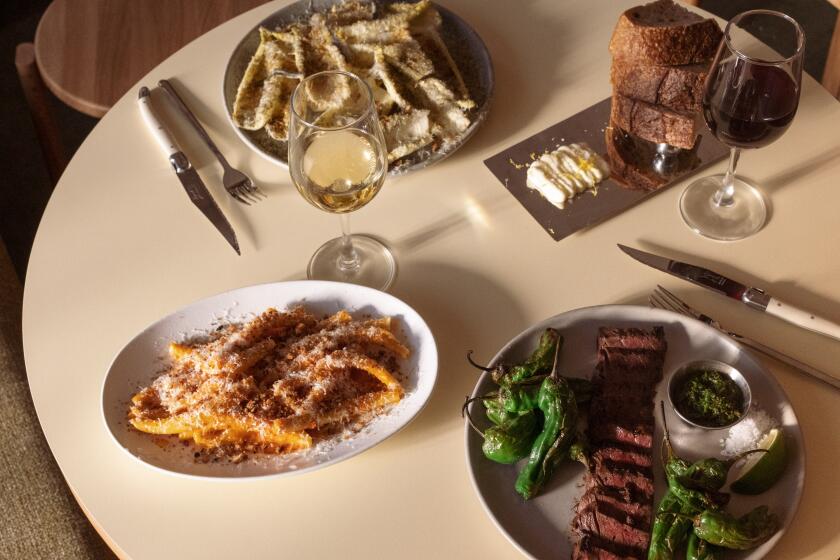Mar Vista’s cookbook queen wants her living room back, so she’s selling treasured titles
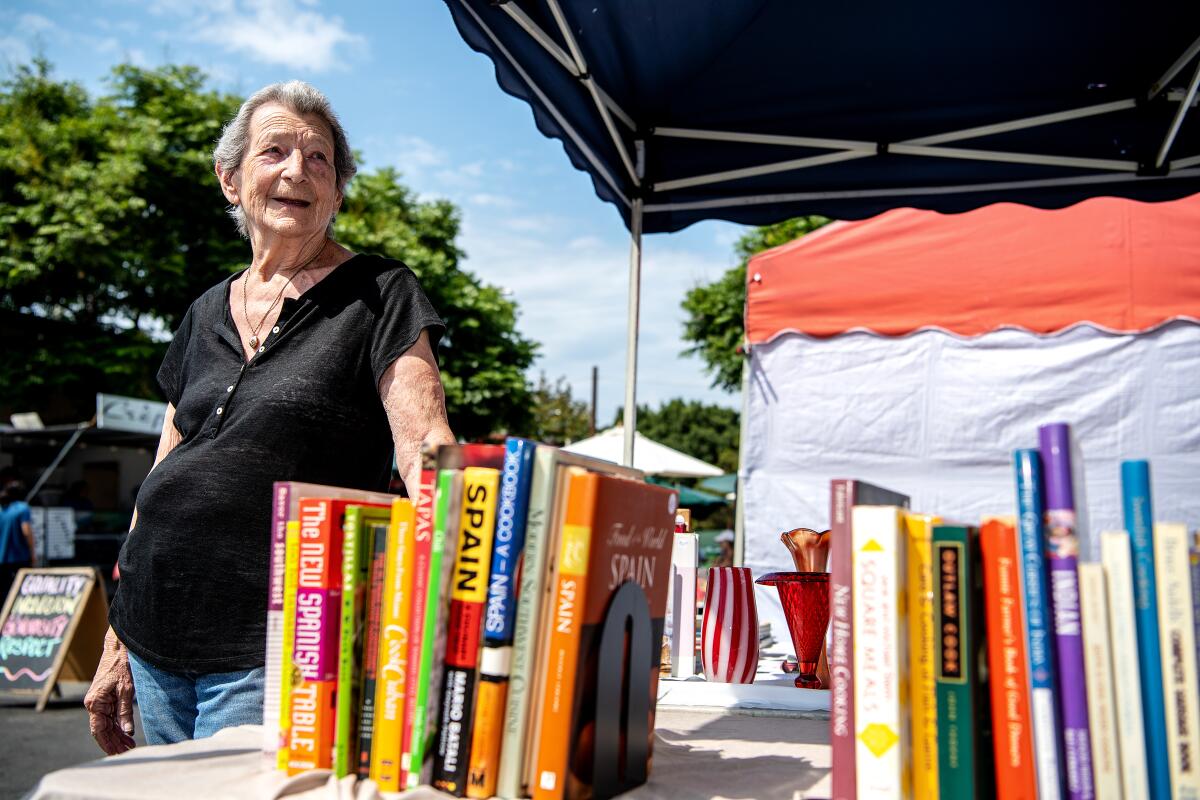
With more than 600 titles in her inventory, Ellin Palmer’s cookbook collection is a time capsule of sorts, representing some of the key volumes of the last 60 years.
Until recently, those books have lived mostly in boxes that have overtaken Palmer’s 400-square-foot apartment, overflowing onto tables and into the bedroom, sequestering Palmer to her kitchen and to one side of the couch.
But now, on select Sundays, she can be found arranging out-of-print pearls for sale at the Mar Vista farmers market and troubleshooting recipes with regulars. Customers frequently linger to talk cooking and trade intel, exchanging the unique currency of kitchen knowledge and anecdotes.
When her interest in cooking was piqued after marrying in 1961, Palmer, now 82, imagined one day owning a bookstore. She would sell antique salt and pepper shakers, and everyone would sit on the sofa and read. “I started to collect cookbooks en masse and booked myself out of existence,” said Palmer. “Now I’m ready to get my living room back.”
There are other reasons for selling the collection. In 2013, Palmer’s older son, Adam, was living with her former husband, who had cancer. Her son unexpectedly died from a heart attack, and her former husband died four days later. Palmer and her younger son, Matthew, were faced with handling the estate, from cars to clothing. Promising Matthew she wouldn’t leave the cookbooks for him to sort out, she put them in boxes. Soon, though, she began adding more titles.
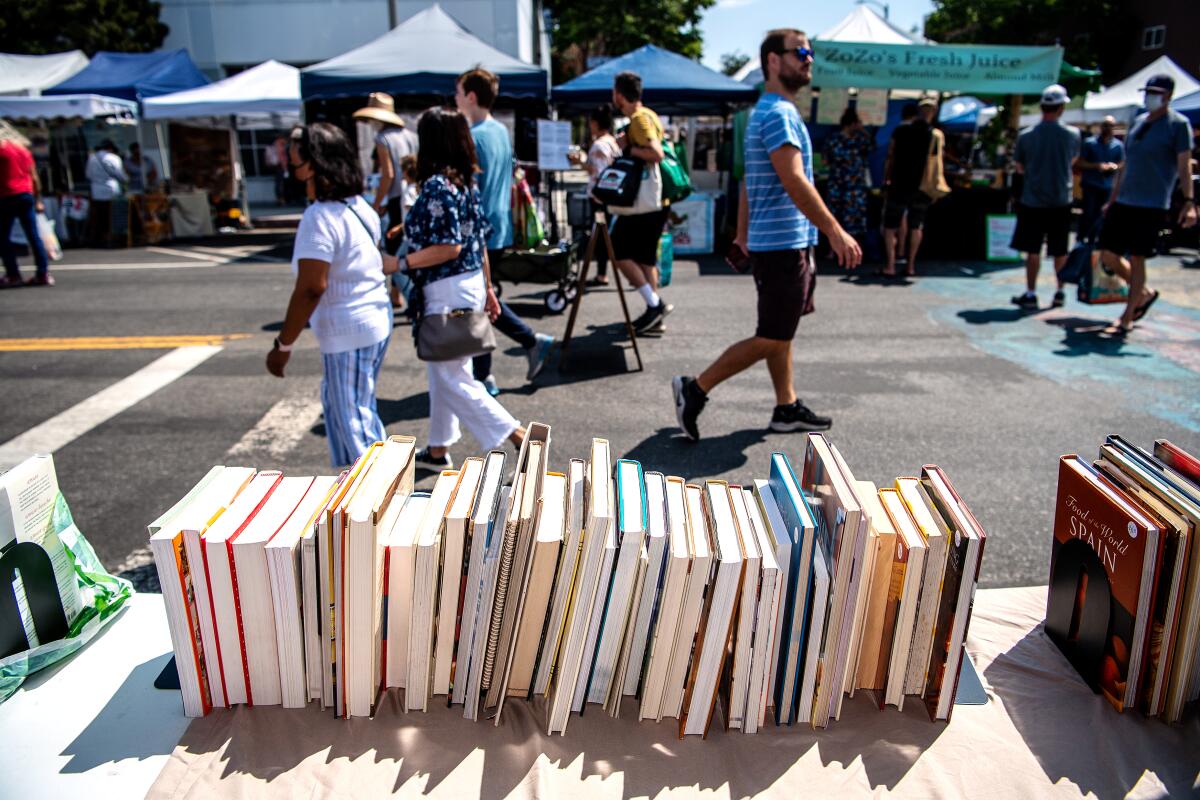
“When my son died, I think I started acquiring more books to fill that void,” said Palmer. “It’s not uncommon to start to hold on to things, to collect things.” But when she was diagnosed with breast cancer in August 2020, she decided to start selling her cookbooks to help pay the medical bills.
“They should go to someone who loves them and treasures the recipes,” she said. “I don’t need to keep them. I’ve read every one of them, I’ve cooked from them — but they’re only guides. It’s natural to pass things on.”
Palmer was born in Brooklyn, met her former husband in Greenwich Village, got married in Queens and then moved to Long Island to raise a family. In 1983, 10 years after separating from her husband, she and Matthew drove across the country in a Chevy convertible to relocate to Los Angeles, where her brothers lived. With her older son in college, Palmer had craved a fresh start, and some sun. Before retiring in the early aughts, she’d fostered a career as a legal assistant to multiple law firms and nourished an interest in dietetics at Santa Monica College. Cookbooks were her throughline.
“I had a husband who said to me, ‘If you don’t know how to cook, I’ll divorce you.’ And he meant it!” said Palmer. “For him, cooking was an act of love, so if I loved him, I’d learn to cook. We divorced, but I came to agree with that. Feeding people, nourishing people, having them enjoy the fruits of your labor — these things are a beautiful gift. It has governed my life for many years.”
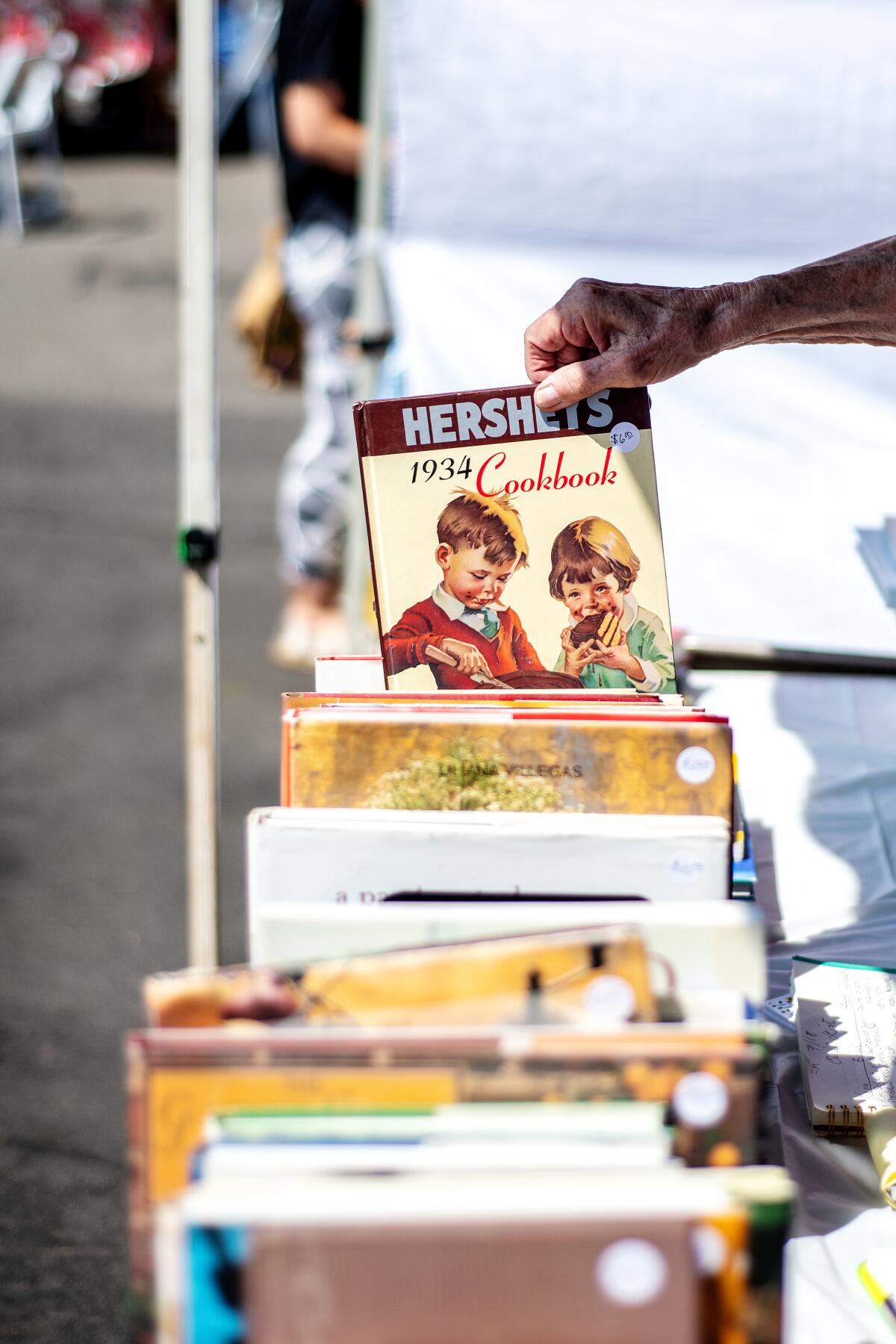
Palmer’s cookbook collection manifests a reverence for the home cook, with entries that represent six decades of advice for feeding families, eating solo, and making weekend meals for 20. Her inventory highlights authors who have shaped how we eat, cook and talk about food in the U.S. — by forging relationships primarily to readers in home kitchens — including Edna Lewis, Madhur Jaffrey, Irene Kuo, Claudia Roden, Joan Nathan, Paula Wolfert, James Beard, Julia Child, Marcella Hazan, Jacques Pépin, Emeril Lagasse and Judith Jones. Browsing Palmer’s titles is like opening a neatly arranged chest of memories made tangible, and to taste.
On a recent Sunday, Palmer’s stand showcased a thick cookbook by Bologna-born chef Biba Caggiano (her restaurant, Biba, became a landmark of Italian cooking in Sacramento when it opened in 1986). On display nearby was a 2001 copy of “The African American Heritage Cookbook” by Carolyn Quick Tillery, who wrote about history through the lens of food by sharing recipes and stories from American institutions like Tuskegee and Howard University. An original copy of “Sunday Suppers at Lucques” (2005) by celebrated Los Angeles chef Suzanne Goin gleamed in its olive-colored binding. Madhur Jaffrey’s “From Curries to Kebabs” (2003) was resplendent in a fuschia dust jacket. “Hawaii Cooks” (2003) by Roy Yamaguchi, who hosted many seasons of a PBS show of the same name in the 1990s, sat beside a first edition of “Chinese Cuisine” (1995) by Susanna Foo, an innovator of Chinese French fusion.
“Served With a Flourish” by Simon Lycett (1999) teaches the home cook a few things about restaurant-worthy presentation: perfectly mottled marzipan pears, sugared rose petals, an open-faced ham sandwich shaped like a pig. If you have ever wondered how to make a beehive from vanilla sponge cake, “Best-Ever Cake Decorating” (1996) gives detailed instructions, along with recipes for a powder-blue cake called Bluebird Bon Voyage and a surprising vegan chocolate gateau. “The Complete Greek Cookbook” by Theresa Karas Yianilos (1970) — one of Palmer’s favorites — highlights some of the best dishes from 3,000 years of Greek cooking.
And it is hard to beat some of Palmer’s prices. “The Complete Book of Indian Cooking” by Suneeta Vaswani (2007) is listed for $145 at one online purveyor and $10 at Palmer’s market stand. Two of her most beloved books have yet to be priced for sale: signed copies of “La Technique” (1982) and “La Methode” (1979) by Pépin, one of her home-cooking heroes. On AbeBooks.com, an online marketplace of fine art and collectible titles, the books go for $500 to $1,000. Though Palmer says she understands the value of her rare and out-of-print cookbooks — and prices them, fairly, above usual markets for used and thrift — don’t look for big-ticket price tags at the farmers market.
“I feel like I can’t even charge $200 for a book. I’d feel terrible,” said Palmer. “I want people to buy the book, and to cook from it.”
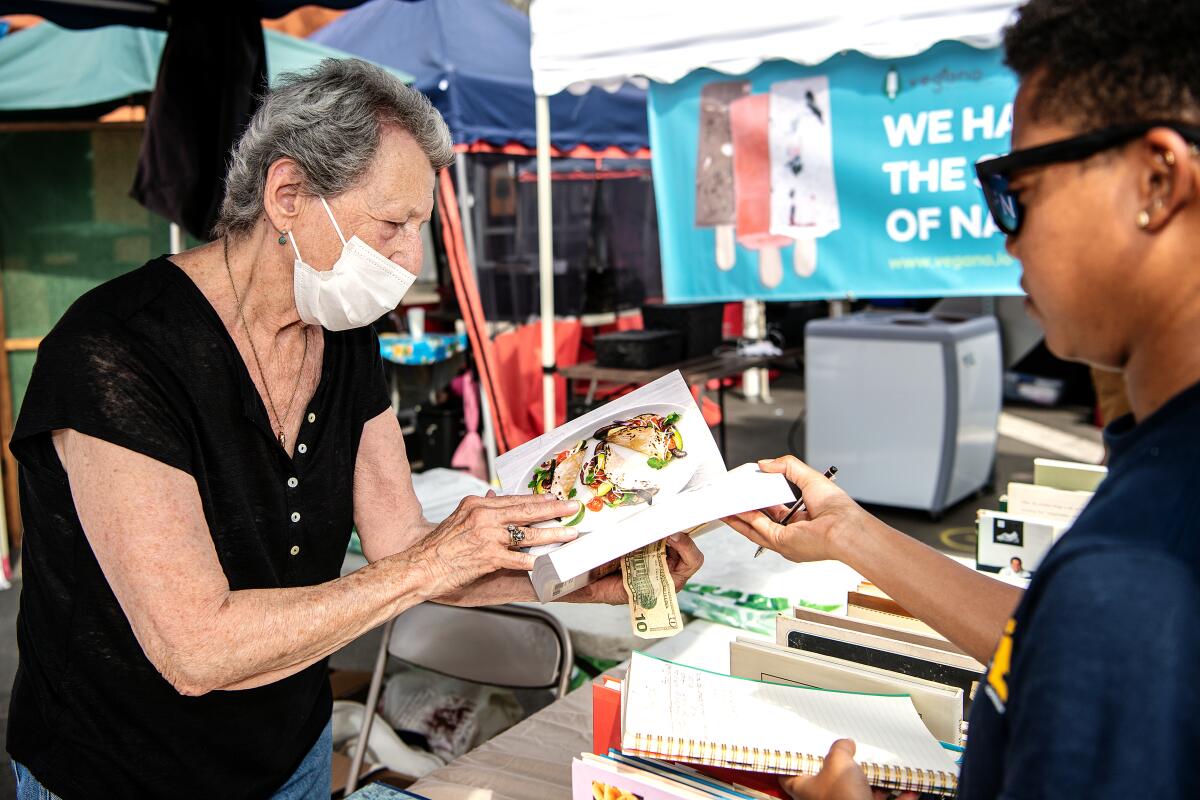
Yet there are reasons for some of the high prices posted elsewhere. “I would say value is about scarcity and rarity, the real archival stuff,” said Ken Concepcion, a former fine-dining chef who co-owns the cookbook store Now Serving in Chinatown. “Even today, a great book on Pakistani food could have a limited initial run of just 3,000 copies. If the publisher doesn’t want to make more than that, it goes out of print. Imagine that happening to a ton of these older titles — it could really drive up the value.”
A signed book can sometimes command a hefty price tag, he added, particularly if the author is no longer alive. Condition is also crucial. Books in Palmer’s inventory are virtually spotless, with no traces of pencil markings, folded corners or vinegar spills. She carries a crisp, freshly printed document with each book in her collection inventoried in alphabetical order. One Sunday, she sold for $25 an original, out-of-print copy of “The Key to Chinese Cooking” (1977) by Kuo, a pivotal American cookbook in nearly perfect condition with its sweet paprika dust jacket.
There are a few cookbooks Palmer won’t sell. “The Complete Armenian Cookbook” by Alice Bezjian is one. So are Jaffrey’s “Vegetarian India”; “Cucina Rustica” by Viana Laplace and Evan Kleiman; “Chez Panisse Vegetables” by Alice Waters; and “The Food of Morocco” by Wolfert.
Throughout the pandemic and chemotherapy, Palmer has continued to cook. Like many, she dabbled with banana bread. When she craved the spicy potatoes from Sunnin Lebanese Cafe on Westwood Boulevard, she learned how to make them at home. Recently, she made chicken wings, which she marinated in garlic, fresh thyme, some olive oil, a little lemon juice — not much — and balsamic vinegar before roasting. She ate them with shelled peas and corn. And she’s been thinking of buying some fish and throwing it into a pot with fresh tomatoes, garlic, shrimp, thick pieces of cod and perhaps littleneck clams. The steaming, fragrant fish stew could be eaten alone or spooned over pasta, which is perfect, she emphasized, since it probably takes longer to cook than the fish.
More to Read
Eat your way across L.A.
Get our weekly Tasting Notes newsletter for reviews, news and more.
You may occasionally receive promotional content from the Los Angeles Times.









